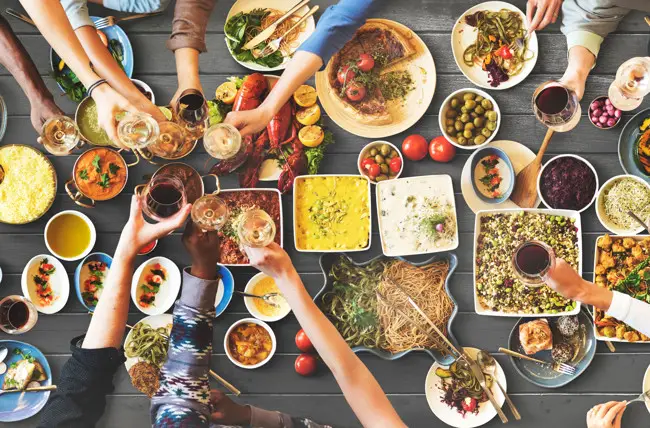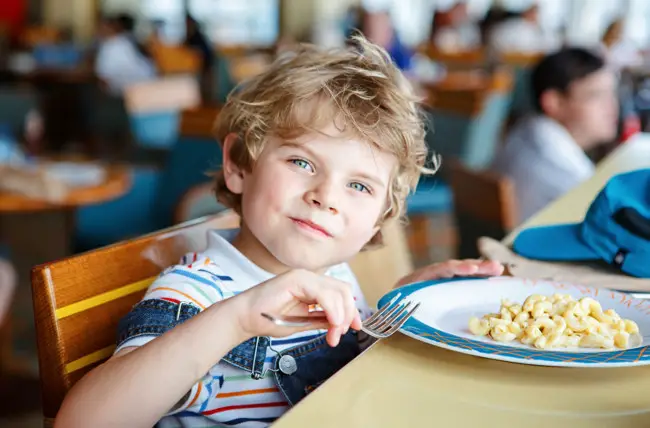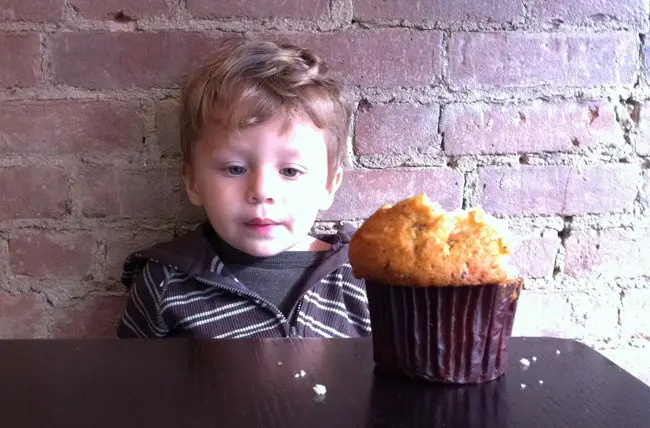Learn the science behind making everyone’s favorite hot chocolate topper.
The puffy, powdery, sweeter-than-sweet candy pillows known as marshmallows are filled with scientific fun. When you make them at home, you’re experimenting with all kinds of cool natural principles: You’re showing how collagen behaves (that’s the protein that makes up all the connective tissue in your body); you’re discovering how sugar forms crystals (and what happens when it gets hot enough to melt); you’re demonstrating how foams are made; and you’re discovering how gelatin gels work. These marshmallows are going to make you so-o-o-o-o smart!
Makes 81 marshmallows
GET THIS
- Three ¼-ounce packets unflavored gelatin (7½ teaspoons)
- 1 cup cold water
- 1 cup light corn syrup
- 1½ cups granulated sugar
- ¼ teaspoon salt
- 2 teaspoons vanilla extract
- 6 drops of food coloring (optional)
- Nonstick cooking spray
- 1/3 cup powdered sugar
- 3 tablespoons cornstarch
- Standing mixer with whisk attachment
- Large, heavy saucepan
- Mixing spoon
- Candy thermometer or high-temp instant-read thermometer
- 9-inch square baking pan
- Small mixing bowl
- Flat metal spatula
- Large cutting board
- Large knife
- Gallon-sized zipper-lock plastic bag or a container with a lid for storing your leftover marshmallows
|
DO THIS
|
Make the Marshmallow Mixture
- Combine the gelatin and ½ cup of the cold water in the bowl of the standing mixer. Attach the whisk attachment and mix briefly to combine.
- Mix the remaining ½ cup cold water, the corn syrup, granulated sugar, and salt in the large, heavy saucepan. Put over medium-high heat, stir to dissolve the ingredients, cover, and cook for 3 minutes.
- Uncover and heat until the syrup is 240°F on a candy or instant-read thermometer. Start measuring after approximately 5 minutes of cooking.
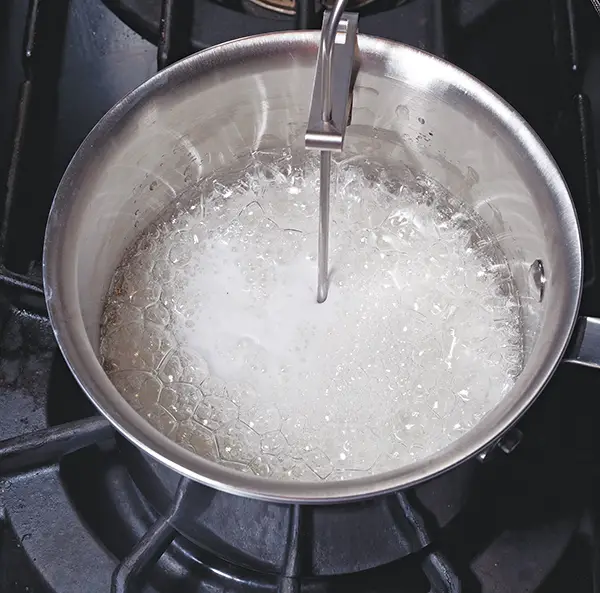
- Immediately remove from the heat. It’s important that the syrup be right at 240°F. If it’s too cold, the marshmallows won’t set. If it gets too hot, the marshmallows will be crunchy instead of chewy.
- Turn the mixer on low speed and, while the machine is running, pour the syrup slowly down the side of the bowl into the gelatin mixture.
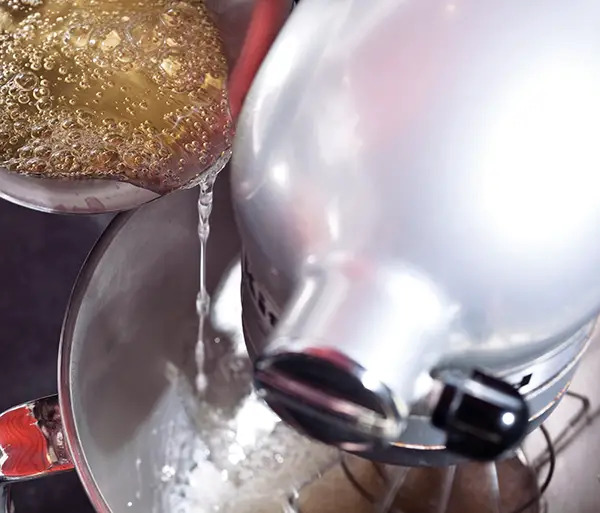
- Once all of the syrup has been added, slowly turn up the speed of the mixer to high. Continue to beat until the mixture is thick and white and barely warm, approximately 10 minutes. In the last minute, add the vanilla (and food coloring, if you want).
Cool the Marshmallows
- Spray the baking pan with nonstick cooking spray. Not too much.
- Combine the powdered sugar and cornstarch in a small bowl. Sprinkle half into the baking pan and tilt the pan to evenly coat the bottom.
- Spray the spatula with nonstick spray and scrape the marshmallow mixture into the prepared pan. Spread the top evenly, making sure the marshmallow gets all the way into the corners of the pan. If the spatula starts sticking to the marshmallow, spray with more oil.
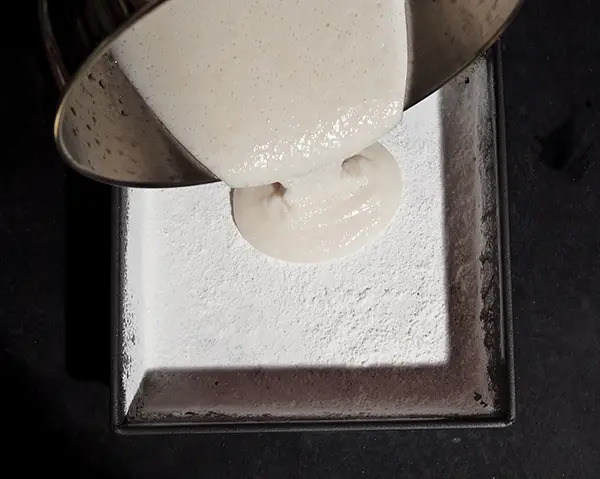
- Dust the top with the rest of the powdered sugar mixture. Set aside to dry for at least 6 hours or, even better, overnight.
Cut the Marshmallows
- Turn the marshmallow sheet out onto the big cutting board and cut into 1-inch squares, coating the knife with more powdered sugar to keep it from sticking, and dusting the cut surfaces of the marshmallows with the powdered sugar mixture that falls out of the pan onto the cutting board.
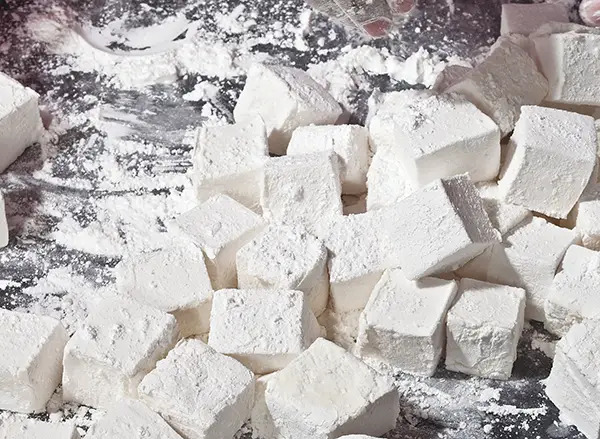
- Eat, and store any leftovers in a tightly sealed plastic bag or container at room temperature for up to 3 months
|
How Did That Happen?
Gelatin is powdered collagen, the main protein in the connective tissue that holds animals’ cells together (including yours). Like all liquid proteins, such as egg white or cream, gelatin thickens, or coagulates, when beaten or whipped.
When you make marshmallows, concentrated hot-sugar syrup is beaten into the gelatin with a mixer equipped with a wire whisk. As the mixer spins, the wires of the whisk force air into the mixture. At the same time, the strings of protein molecules in the collagen get tangled up around pockets of air.
As more and more air gets incorporated into the protein tangle, the mixture starts to inflate, getting bigger and bigger. Soon, the little bit of gelatin in the bottom of the mixing bowl is filling the whole bowl! The beating continues as the gelatin cools, until eventually it solidifies, trapping the air inside the bubble walls. The finished marshmallows are both chewy (from coagulated protein) and fluffy (from lots of air bubbles).
RELATED:
Find Kids’ Cooking Classes Near You
Find After-School Science Programs Near You






















